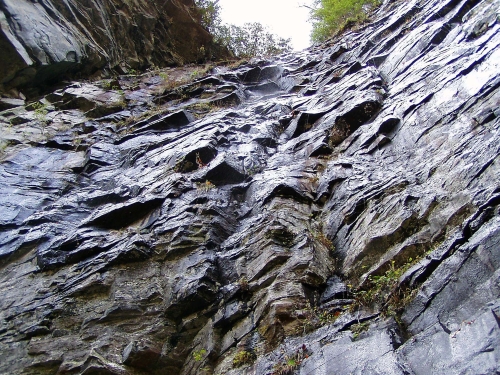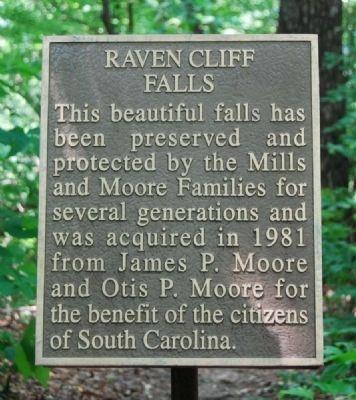Fee and Hours
Trail access fee: $2 adults; $1.25 SC seniors; age 15 &
younger free and Days and Hours of Operation: M-Su 9am-6pm
(extended to 9pm during daylight savings time). During daylight
savings time the trails close one hour before sunset.

Follow the red blazes on the trees and the signs to the falls
because two other, much more difficult, trails (including a spur of
the Foothills Trail) intersect the Raven Cliff Falls Trail.
About the Area
Raven Cliff Falls is the king of South Carolina waterfalls at an
huge drop in tons of feet. Matthews Creek plunges off Raven Cliff
Mountain at the Blue Ridge Escarpment near Caesars Head. The
escarpment is where the Blue Ridge Mountains (part of the
Appalachian chain) drop abruptly 2,000 feet to the Piedmont below.
This sudden drop is the geologic reason why there are so many falls
in the area. A very popular 4.4-mile roundtrip trail leads to an
overlook across the gorge from the falls. The 4.4-mile hike is
moderately difficult with steep descents in the first .25 mile and
last .75 mile. That means you will have to ascend on the return
trip. When you reach a set of stairs on this trail, you are near
the halfway point. When you reach the shelter, turn left to begin
the final .75 mile descent to the overlook. Caesars Head State Park
is part of the Mountain Bridge Wilderness, a 40,000-acre preserve
in northwestern South Carolina

A waterfall is usually a geological formation resulting from
water, often in the form of a stream, flowing over an
erosion-resistant rock formation that forms a sudden break in
elevation or nickpoint. Some waterfalls form in mountain
environments where the erosive water force is high and stream
courses may be subject to sudden and catastrophic change. In such
cases, the waterfall may not be the end product of many years of
water action over a region, but rather the result of relatively
sudden geological processes such as landslides, faults or volcanic
action.
How Waterfalls are Formed
Typically a stream or river flows over a large step in the rocks
which may have been formed by a fault line. Over a period of years,
the edges of this shelf will gradually break away and the stream
will retreat upstream, creating a gorge of recession. Often the
rock just below the more resistant shelf will be a softer type,
meaning some undercutting will occur due to the splashback of the
falling water. A shallow cave-like formation known as a rock
shelter or plunge pool under and behind the waterfall will form.
Eventually the outcropping of rock will collapse under pressure to
add blocks of rock to the base of the waterfall. These blocks of
rock are then broken down into smaller boulder as they collide with
each other and they also will continue to erode at the base of the
waterfall by abrasion, creating a deeper plunge pool. Streams will
become wider and more shallow just above waterfall due to the
flowing of the water over the rock shelf and there is usually a
deep pool just below the waterfall because of the kinetic energy of
the water hitting the bottom.The rock canyon surrounding this
waterfall is a direct result of the above information. Over several
thousands of years, Mother Nature has used the creek to carve out
the the Falls that exist today.
Types of Waterfalls
Block: Water descends from a relatively wide stream or
river.
Cascade: Water descends a series of rock steps.
Cataract: A large waterfall.
Fan: Water spreads horizontally as it descends while remaining
in contact with bedrock.
Horsetail: Descending water maintains some contact with
bedrock.
Plunge: Water descends vertically, losing contact with the
bedrock surface.
Punchbowl: Water descends in a constricted form, then spreads
out in a wider pool.
Segmented: Distinctly separate flows of water form as it
descends.
Tiered: Water drops in a series of distinct steps or falls.
Multi-step: A series of waterfalls one after another of roughly
the same size each with its own sunken plunge pool.
To get credit for this earthcache please answer the
following
a)Describe what type of waterfall Raven Cliff Falls is--this may
include more than one of the classifications.
b) Estimate the height these falls. (needs to be within 10
feet)
If you like include a picture of the falls that is great but
its not required, please just enjoy this wonderful
waterfall
